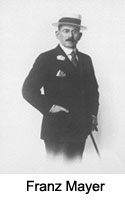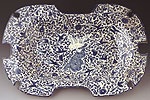The Grandeur of Viceregal Mexico: Treasures from the Museo
Franz Mayer,
The astute
judgment of Franz Mayer and his passion for collecting the arts
of colonial Mexico led to the creation of a museum in his name
in Mexico City. A stunning selection of objects spanning three
centuries drawn from that museum's impressive permanent collection
is the focus of The Grandeur of Viceregal Mexico: Treasures from
the Museo Franz Mayer.
 |
Mayer,
a German immigrant, settled in Mexico City in 1905 and began
seriously collecting about 1920. By that time, he was a noted
banker and financier. When he died, he left his collections
as a legacy to the people of Mexico. The museum named for
him, housed in a beautifully restored 16th-century hospital,
opened to the public in 1986. The Grandeur of Viceregal Mexico
contains more than 150 objects, including painting and sculpture,
inlaid and richly carved furniture, silver, gold, and iron
pieces, and Talavera earthenware, all produced from 1521 to
1821. The MFAH and the Museo Franz Mayer organized the exhibition,
which will travel to Winterthur Museum, Garden & Library
in Winterthur, Delaware and to the San Diego Museum of Art. |
"The
arts of Mexico's colonial era are still not well-known, even in
Mexico," said Peter C. Marzio, director of the MFAH. "This
exhibition offers a rare glimpse at the material culture of that
time. The museum is especially pleased to be the opening venue
for this fascinating collection."
 "Franz
Mayer had an exceptional eye for finding everyday objects with
artistic value," said David B. Warren, director of Bayou
Bend Collection and Gardens at the MFAH and curator of the exhibition.
"What's more, he clearly understood that a collection of
such objects could tell something about the country's history
at a particular point in time."
"Franz
Mayer had an exceptional eye for finding everyday objects with
artistic value," said David B. Warren, director of Bayou
Bend Collection and Gardens at the MFAH and curator of the exhibition.
"What's more, he clearly understood that a collection of
such objects could tell something about the country's history
at a particular point in time."
Mayer had
that vision in common with his contemporaries in the United States,
Miss Ima Hogg in Houston and Henry Francis du Pont in Winterthur,
Delaware, who both collected American decorative arts. All three
are linked by the extraordinary collections that reflect the colonial
pasts of their respective countries and all three left their collections
to be shared with the public.
The Franz
Mayer Collection
Mayer's collection
reveals a fascinating confluence of cultures from Europe, Asia,
and Meso America that gives the art of Mexican style its unique
qualities. Spanish taste, itself heavily influenced by the Near
Eastern culture of the Moors, with all its baroque flamboyance,
was introduced to Mexico at an early date. Similarly, the arts
of China made their mark in Mexico as export luxuries came in
the Manila Galleon to Acapulco and then were transshipped over
land to Vera Cruz for the final sea voyage to Spain. The native
Meso American culture also survived and was adapted in interesting
ways. The tin-glazed wares known as Talavera are considered emblematic
of the diverse influences on Mexican art.
The baroque
period ended in 1783 with the founding of the Nobles Artes de
San Carlos in Mexico City, an academic institution that embraced
neoclassicism, the European art movement of the Enlightenment.
Examples reflecting the new influence are included in the final
section of the exhibition.
 Religious
objects are among the highlights in the exhibition. The show includes
a missal stand, c. 1760, that is exceptional because it is entirely
worked in cast silver without the wooden framework used by many
artisans to cut costs on materials. No other colonial Mexican
missal stand is known to surpass this one in craftsmanship. Another
silver piece, an alms tray, c. 1700-1725, features a star-shaped
plate and naturalist engravings. Alms trays were frequently modified
or remade because they were in high demand from collectors. This
tray is one of the few in existence in which both the plate and
the ornamentation are original, not a fusion of elements. That
makes it an outstanding piece for its authenticity as well as
for its craftsmanship and beauty of design.
Religious
objects are among the highlights in the exhibition. The show includes
a missal stand, c. 1760, that is exceptional because it is entirely
worked in cast silver without the wooden framework used by many
artisans to cut costs on materials. No other colonial Mexican
missal stand is known to surpass this one in craftsmanship. Another
silver piece, an alms tray, c. 1700-1725, features a star-shaped
plate and naturalist engravings. Alms trays were frequently modified
or remade because they were in high demand from collectors. This
tray is one of the few in existence in which both the plate and
the ornamentation are original, not a fusion of elements. That
makes it an outstanding piece for its authenticity as well as
for its craftsmanship and beauty of design.
 Women
were rarely depicted in colonial Mexican portrait painting in
the 16th and 17th centuries. That changed in the 18th century,
when female portraiture became increasingly popular. The exhibition
offers a fine example of such work in Portrait of a Lady,
1782, by Miguel de Herrera. The skilled rendering in oil on canvas
shows a young lady with an elaborate coiffure bearing large colorful
feathers.
Women
were rarely depicted in colonial Mexican portrait painting in
the 16th and 17th centuries. That changed in the 18th century,
when female portraiture became increasingly popular. The exhibition
offers a fine example of such work in Portrait of a Lady,
1782, by Miguel de Herrera. The skilled rendering in oil on canvas
shows a young lady with an elaborate coiffure bearing large colorful
feathers.
 Many
outstanding examples of Talavera earthenware from various eras
are included in the show, each revealing something about the country's
history. A platter from the late-17th century made in Puebla,
Mexico shows a lavish use of cobalt blue, which was extraordinary
considering its value at the time. In its decoration, the piece
shows Hispano-Muslim conventions combined with motifs and decorations
of European, Chinese, and native Mexican origin. By the first
quarter of the 19th century, Pueblo ceramists began to tire of
the blue-and-white decoration that had predominated for more than
150 years. They began to use polychrome decoration as ground coloration
and to render motifs. An inkwell and tureen, both early 19th-century,
were made with a pale-blue background. Vibrant flowers in yellow,
orange, green, blue, and manganese decorate the pieces.
Many
outstanding examples of Talavera earthenware from various eras
are included in the show, each revealing something about the country's
history. A platter from the late-17th century made in Puebla,
Mexico shows a lavish use of cobalt blue, which was extraordinary
considering its value at the time. In its decoration, the piece
shows Hispano-Muslim conventions combined with motifs and decorations
of European, Chinese, and native Mexican origin. By the first
quarter of the 19th century, Pueblo ceramists began to tire of
the blue-and-white decoration that had predominated for more than
150 years. They began to use polychrome decoration as ground coloration
and to render motifs. An inkwell and tureen, both early 19th-century,
were made with a pale-blue background. Vibrant flowers in yellow,
orange, green, blue, and manganese decorate the pieces.
 Beautifully
designed furniture and objects designed for everyday use also
are part of the collection. A wardrobe of carved wood, 1750-1800,
features an exquisite ornamental headpiece, which is more closely
related to altarpiece construction than furniture design. The
door panels bear round mirrors surrounded by well-crafted rocaille.
Exquisite detail is also evident in a snuffbox, c. 1810, made
by renowned silversmith José María Rodallega. The
box, made from cast, chiseled two-tone gold, shows a French influence
in its structural design and in the chromatic interplay of the
two colors of gold. The lid of the rectangular box has hidden
hinges and is decorated with borders of engraved leaves, vines,
and hanging flowers.
Beautifully
designed furniture and objects designed for everyday use also
are part of the collection. A wardrobe of carved wood, 1750-1800,
features an exquisite ornamental headpiece, which is more closely
related to altarpiece construction than furniture design. The
door panels bear round mirrors surrounded by well-crafted rocaille.
Exquisite detail is also evident in a snuffbox, c. 1810, made
by renowned silversmith José María Rodallega. The
box, made from cast, chiseled two-tone gold, shows a French influence
in its structural design and in the chromatic interplay of the
two colors of gold. The lid of the rectangular box has hidden
hinges and is decorated with borders of engraved leaves, vines,
and hanging flowers.
About Franz
Mayer
Franz Mayer
(1882-1975) obtained an independent stockbroker's license one
year after arriving in Mexico, and was a founding member of the
Mexican Stock Exchange. His charisma helped him gain entry into
the elite social circles of the day. Soon he established himself
as one of the country's top investors and eventually accumulated
a vast fortune. When he began collecting, his eye for valuable
objects was enhanced by his tremendous purchasing power, the thrill
of the deal, and a love of bargain hunting. He became known as
"the crazy old German who would buy an owner a new flower
pot in exchange for an old one." His collection was thinned
and refined in later years when he became a partner with one of
the most important antique galleries in Mexico City. As his interests
and collection expanded, he hired agents to locate fine and decorative
art objects, either Mexican or related to the country, from all
over the world. In addition to his passion for collecting, Mayer
was an avid traveler, photographer, and gardener.
Exhibition
Web Site
The MFAH and
faculty and graduate students in the Instruction
Technology Program in the College
of Education at the University
of Houston, have developed a comprehensive exhibition Web
site for The Grandeur of Viceregal Mexico. Visitors to the site,
http://www.fm.coe.uh.edu,
will be able to learn how works of art in the exhibition show
influences of the indigenous Pre-Columbian cultures, of Spanish
and Islamic art, and of the art from China and the Philippines.
One feature compares furniture, portraits, ceramics, and silver
from the Museo Franz Mayer with similar objects produced in Boston,
Philadelphia, and New York to demonstrate how life in the Spanish
and British colonies in the New World were alike and very different.
Interactive games for children on the site will help them learn
how goods were transported to Mexico from Spain and the Far East,
and to design their own ceramic pieces, create a book of works
in the exhibition, and create crazy combination portraits. Teachers
will find easy-to-use lesson plans focusing on art and social
studies for students of all ages.
The Web site
also documents the 2001 cultural exchange between students in
Houston and in Mexico City and the art they created and provides
background information on the museum, Bayou Bend, and the Museo
Franz Mayer. During the run of the exhibition, the museum, for
the first time, will experiment with Web casting selected exhibition
lectures.